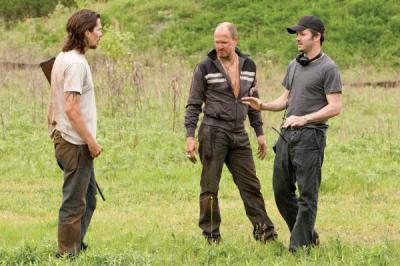By: debbie lynn elias
Writer/director Scott Cooper steeps his stories in truth, in history, in blue collar America. We saw this with his award-winning, Crazy Heart. We see it now again at an even deeper, more visceral level with OUT OF THE FURNACE. As the grandson of a Virginia coal miner, it’s a world he knows well. “ I have grown up with these people and have spent a lot of time in small town America. . .That blue collar milieu was something that I really understood and resonated with me. . .I knew these people very well and I knew their mores and their values, and I hoped to think that I knew about their world view, and that it was important to weave all of those themes into a narrative in a very personal way.”

Shooting a film in the heart of the Rust Belt in Braddock, Pennsylvania is not exactly in the mainstream. Writing the script and the characters so as to embrace and embody the world of the Allegheny Mountains and its lifeline waterway, the Monongahela River, is even more surprising; surprising that is if you don’t know Scott Cooper. “I had been reading a great deal about Braddock, Pennsylvania. What the town had undergone over the past five to seven years dealing with economic turmoil and the loss of the steel industry really touched me. It was important to me to really shine a light not only on small town America like that but also what we as Americans have undergone these past five turbulent years.”
But as passionate as Cooper is about Braddock and its blue collar world, equally so is his cast, each of whom was touched in their own way by the region and its people.
For Christian Bale, location is key to informing his performance and immersing himself in Braddock and the Alleghenies just added fuel to his character’s fire. “It helps so much being on location. . .It’s like the difference between performing for the rectangle of the camera versus a world being created and then the camera finds things within that. . . You don’t feel like performing. You’re just kind of doing it; you’re existing.”
Echoing Bale’s sentiment is Casey Affleck who also imbues his character with the emotion and perspective of returning veterans facing not only a tough economy, but post-traumatic stress and challenges of assimilation back into the “real world”. “There’s a real story just in the way that it looks to see a place that was once one thing and is now something else. It has a lot of atmosphere.” As Affleck notes, often when making movies there is down time associated with lighting set-ups, set changes. When steeped in the actual location and in the actual homes and shops of the townspeople, it allows him to just “ go into another room. You’re not just staring at the back of a bunch of plywood. You’re actually in another room in your own house where you’re supposed to be, and it helps to ground you and keep you.”
As the lone female in the group of lead actors, Zoe Saldana brings a unique sensitivity and awareness to Cooper’s perspective. “You walk in with this fear. . .and what you learn and you take from it is the strength that you’re able to absorb from these people. It’s very easy to leave when things go wrong, but to stick around and to basically give life to a town because of everything that it gave you generation after generation after generation, that to me is what defines a true American. . . Once you sit down with the people, you kind of wish you had an ounce of the strength that they possess every single day by sticking around. That was something that I really was very moved by.”
#
11/16/2013












